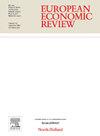宏观进化中的奇点建模
IF 2.4
2区 经济学
Q1 ECONOMICS
引用次数: 0
摘要
宏观进化动力学经常表现出突然的、爆炸性的激增,系统在经历经常超过传统指数增长的急剧加速之前,在很长一段时间内保持相对稳定。这种模式在生物进化、文化转变和技术进步中都很明显,通常被称为奇点的出现。尽管它们广泛发生,但这些爆炸在不同领域有不同的潜在机制。在这种情况下,我们提出了一个统一的框架,通过组合创新理论来捕捉这些动态。在相邻可能性理论的基础上,我们将宏观进化变化建模为一个由系统中预先存在的元素重新组合驱动的过程。通过形式化这些定性的见解,我们提供了一个数学结构来解释这些爆炸性现象的出现,促进了不同系统之间的比较,并使对未来进化轨迹的预测成为可能。此外,通过比较理论的离散和连续形式化,我们强调应该仔细考虑这些假定奇点的发生和观察,因为它们来自固有离散模型的连续极限。本文章由计算机程序翻译,如有差异,请以英文原文为准。
Modelling singularities in macroevolution
Macroevolutionary dynamics often display sudden, explosive surges, where systems remain relatively stable for extended periods before experiencing dramatic acceleration that frequently exceeds traditional exponential growth. This pattern is evident in biological evolution, cultural shifts, and technological progress and is often referred to as the emergence of singularities. Despite their widespread occurrence, these explosions arise from distinct underlying mechanisms in different domains. In this context, we present a unified framework that captures these dynamics through a theory of combinatorial innovation. Building on the Theory of the Adjacent Possible, we model macroevolutionary change as a process driven by recombining pre-existing elements within a system. By formalising these qualitative insights, we provide a mathematical structure that explains the emergence of these explosive phenomena, facilitates comparisons across different systems, and enables predictive insights into future evolutionary trajectories. Moreover, by comparing discrete and continuous formalisations of the theory, we emphasise that the occurrence and observation of these presumed singularities should be carefully considered, as they arise from the continuous limit of inherently discrete models.
求助全文
通过发布文献求助,成功后即可免费获取论文全文。
去求助
来源期刊

European Economic Review
ECONOMICS-
CiteScore
4.70
自引率
3.60%
发文量
170
期刊介绍:
The European Economic Review (EER) started publishing in 1969 as the first research journal specifically aiming to contribute to the development and application of economics as a science in Europe. As a broad-based professional and international journal, the EER welcomes submissions of applied and theoretical research papers in all fields of economics. The aim of the EER is to contribute to the development of the science of economics and its applications, as well as to improve communication between academic researchers, teachers and policy makers across the European continent and beyond.
 求助内容:
求助内容: 应助结果提醒方式:
应助结果提醒方式:


